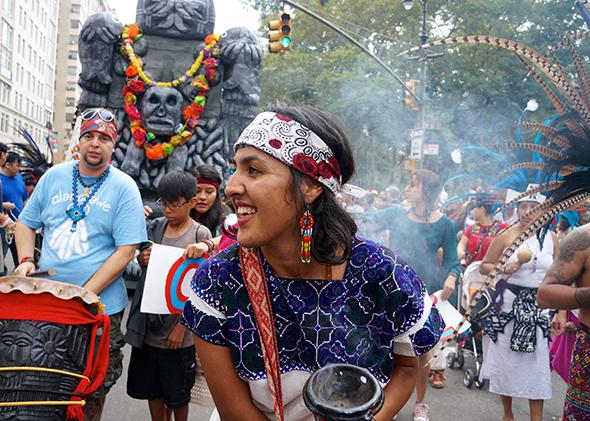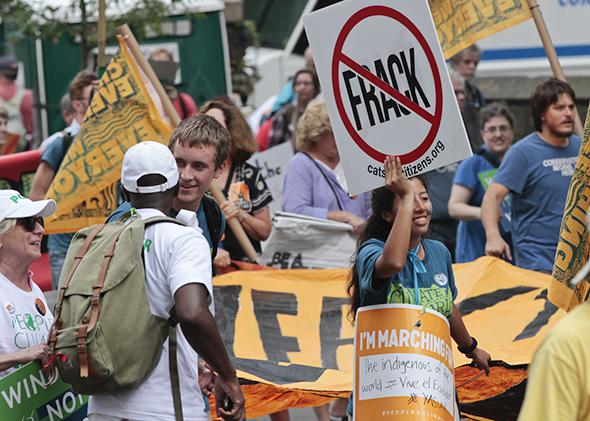At the front of the People’s Climate March, moments before the crowd began to move, you could look back and see the wall of stone that makes up the wealthy Upper West Side apartment buildings to your left, and Central Park to your right, in the last of its full-blown green phase before the leaves start to turn. Visible on the street: signs, artwork, and many, many heads.
In the front section of the march, designated by organizers for “the people first and most impacted,” were representatives of the Kichwa from Ecuador, Taino from the Caribbean, Winnemem Wintu from California, and many other indigenous groups in traditional clothing. There were also members of the media and the musician Sting. Young people of color from Brooklyn held large paper sunflowers and an enormous banner reading: “FRONTLINES OF CRISIS, FOREFRONT OF CHANGE.” Above them were the glossy towers that mark the beginning of Midtown and the bright red CNN sign against the fog signaling that the 11:30 a.m. start time was drawing closer. On his spire, Columbus had his back to the crowd.
The march was already the largest climate demonstration in history before the walking began. There was plenty of excitement. But the drums, the chanting, and the drone of conch-shell horns added an air of warfare.
Indigenous and underprivileged communities are already experiencing the worst impact of climate change, and for those at the front of the march, battle-ready would seem an appropriate posture.

Photo by Cem Ozdel/Anadolu Agency/Getty Images
Ricken Patel, the founder of the online activist network called Avaaz, told us shortly before the march: “We know that the most vulnerable communities get if first and worst every time.” The refrain was repeated by so many others, and research corroborates it. An analysis from Yale and George Mason University finds that in the United States, climate change is most likely to affect “Hispanics, African Americans, and other racial and ethnic groups who are likely to be more vulnerable to heat waves, extreme weather events, environmental degradation, and subsequent labor market dislocations.”
The people at the front of the march were themselves a sign that the face of mainstream climate activism has shifted from polar bears and Priuses toward marginalized communities. It is, in theory, a shift from what climate researcher Angela Park wrote in 2009 was a movement that “still suffers from the perception, and arguably the reality, that it is … led by and designed for the interests of the white, upper-middle class.”
Seven representatives from frontline communities spoke at a press conference before the march began, including Kathy Jetnil-Kijiner, a 26-year-old writer, professor, and spoken-word artist from the Marshall Islands. She has also been selected by the United Nations from a group of 544 nominees to speak in the opening ceremonies of Tuesday’s Climate Summit.
We caught up with her after the march. Jetnil-Kijiner is small in stature, with long black curly hair, and she appeared exhausted after arriving from the Marshall Islands just the day before the march (not to mention marching and speaking to reporters all day), but she managed to reanimate herself. Walking in Central Park, she told us that she first felt called to climate activism after returning to the Marshall Islands after college in 2010. “There are some parts of the Marshalls where you can stand and see both sides of the ocean,” she said. Rising sea levels, one of the most devastating and permanent consequences of climate change, threaten the very existence of low-lying island nations. In 2008, she woke one morning to find her home island flooded. Houses were destroyed, debris was everywhere, and once the waters receded, the trees shriveled because of the salt.
While people like Jetnil-Kijiner were physically at the front of the march, the question remains whether their voices will be drowned out by the bigger names of climate activism, the Bill McKibbens and the Ricken Patels.

Photo by Lisa Larson-Walker
The night before the march, McKibben and other writers and politicians spoke on a panel in the packed Unitarian Church of All Souls on the Upper East Side. Nearing the end of the discussion, the moderator, Brian Lehrer, asked McKibben what was the unified message that he wanted people to take away from the march. Instead of answering, McKibben metaphorically passed the mic, saying, “There will be people from communities who have had to deal with Sandy, the ongoing fact of living in a place where every third kid has an inhaler. They’ll do a good job of speaking powerfully.”
Just before the march, Ananda Lee Tan, an organizer with the Global Alliance for Incinerator Alternatives, told us, “We’re seeing a shift in the movement. This march really marks a flipping of the script.” Tan explained that the communities most impacted by extreme weather have joined together. “We’re taking over the leadership of the U.S. climate movement,” he said, “and so we’ll see on the streets today probably the most diverse, broad, grass-roots climate movement that the U.S. has ever seen.”
The difference is not that communities most threatened by climate change are now involved in the climate change movement. As Jacqueline Patterson, the NAACP’s Environment and Climate Justice Program director, pointed out in a phone interview, frontline communities have been involved in climate justice from the beginning of the movement. What’s new is that a wide range of groups, from labor unions and indigenous tribes to the Granny Peace Brigade, was marching in the same place.

Photo by Lisa Larson-Walker
Still, Patterson had a more cautious view of the role of frontline communities in the march and the wider movement. She said that while there was now more acknowledgement that frontline communities needed to be engaged, there was “to a lesser extent, an acknowledgement that the frontline communities need to lead.”
On the Wednesday before the march, a 28-year-old Avaaz canvasser (who preferred to remain anonymous, citing a nondisclosure agreement) echoed Patterson’s concerns. He said there was much improvement in the communication with frontline communities, but he was skeptical of the “big greens” such as Avaaz, 350.org, and the Sierra Club, arguing that they needed to deepen their understanding of organizing in frontline communities. “There’s a lot of wisdom there,” he said. Specifically, he wanted the established environmental organizations to give more money directly to grass-roots organizations. He told us that he planned to quit his canvassing job that evening. He didn’t want to canvas in Washington Square Park anymore; he planned to return to his home community of Staten Island to organize there.
The test of the movement’s potency will, of course, be its coordination beyond the march, its ability to maintain the unity that defined it. And on Tuesday, Kathy Jetnil-Kijiner will have an opportunity to tell world leaders about the Marshall Islands, about what it is like to live on land just two meters above sea level. She is tired of answering the question of where the Marshall Islanders will move when the islands are gone. “We don’t want to move, and we shouldn’t have to move,” she said. “There should be changes now so that doesn’t have to happen.”
